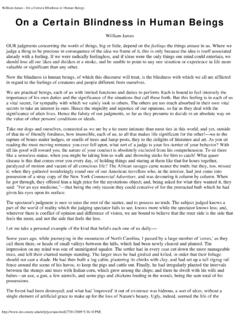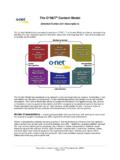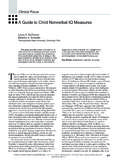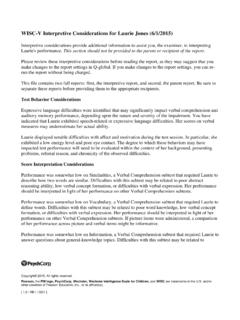Transcription of TheMeasurementofGiftedness - Positive …
1 Chapter 48 The Measurement of GiftednessLinda Kreger SilvermanAbstractInstruments with the richest loadings ongeneral intelligence (g) are the most useful for locatinggifted children. Spearman s Progressive Matrices, Stanford-Binet scales,and Wechsler scales are the most widely used IQtests in selecting gifted children worldwide. All werefounded on the conception of intelligence as abstractreasoning (g), but each may locate a different groupof gifted children. If index scores vary significantly,Full Scale IQ scores should not be derived.
2 The newGeneral Ability Index (GAI) of the WISC-IV, based ononly six subtests, is recommended by the NAGC TaskForce for selection of students for gifted Verbal Comprehension Index and PerceptualReasoning Index can also be used independently,as can the Verbal and Nonverbal IQ scores of theSB5. Ratio IQ methods and supplementary testingare recommended for locating exceptionally giftedchildren and for determining degree of tests General intelligence Wechslerscales Stanford-Binet scales Raven s ProgressiveMatricesOrigins of the Measurementof IntelligenceThe infinite variability of human beings is so remark-able that one would assume it had been one of Silverman (B)Institute for Advanced Development, Denver, CO, USAe-mail: topics of scientific interest.
3 Yet, the explorationof individual differences began less than 140 yearsago, in the latter part of the nineteenth century. Thestudy of giftedness is imbedded historically and philo-sophically within the study of individual differencesin intelligence. Sir Frances Galton (1869, 1883), father of the testing movement (Shouksmith, 1970),inaugurated this field of study. Considered a geniushimself (Terman, 1917), Galton (1869) may have beenamong the first to use the term gifted to refer toindividuals of higher intelligence.
4 He was the firstinquirer to furnish a comprehensive description ofthe traits of gifted children (Hildreth, 1966), as wellas information about the origins and development this time, it was commonly believed that ev-eryone (except perhaps freaks of nature) had the samenative endowment. Galton (1869) provided the firstquantitative analysis of human intelligence in his book,Heredity devised the use of percentiles forranking individuals and demonstrated that there wasenormous variability in the population. Employing thenormal curve as a model, he showed that individualsat the extremes differ from each other to a greater ex-tent than individuals near the average.
5 InInquiries intoHuman Faculty and its Development, Galton (1883)explored the feasibility of measuring mental capaci-ties with discrimination tasks, such as discerning thesequence of a set of weights. This was followed byhis creation of the first mental tests, which involvedmeasures of sensory capacity. He set up the first men-tal testing center in 1884 at the International HealthExhibition in London and charged visitors a fee formeasuring the acuity of their senses (DuBois, 1970).In this manner, he assessed nearly 10,000 individu-als, ranging in age from 5 to 80 years.
6 While Galton Shavinina (ed.),International Handbook on Giftedness,947 DOI ,c Springer Science+Business Media Silvermanexperiments in testing failed, his influence was im-mense (Carroll, 1993) and a new field was s successors were Karl Pearson and JamesMcKeen Cattell. Pearson refined Galton s conceptof co-relation, creating the mathematical procedurefor statistical correlation, essential in factor analy-sis and in determining test validity and reliability(DuBois, 1970). The Pearson product moment for-mula for linear correlation is now in universal use,as well as his many other statistical procedures,including multiple correlation and the chi square testfor goodness of fit.
7 James McKeen Cattell, Galton sassistant in his Anthropometric Laboratory, was thefirst researcher in America to promote mental testing;he coined the term mental test (J. M. Cattell, 1890).Cattell set up the first testing laboratory in on Galton s methodology, he developed 50tests of sensory capacity, discrimination and reactiontime and attempted to use his measures to selectsuperior individuals for responsible positions. Asthese simple measures failed to differentiate cognitiveabilities, his endeavors, like his mentor s, did not provefruitful (Cronbach, 1970).
8 Galton was obsessed withthe role of heredity in intelligence, but Cattell partedcompany with him on that issue; he maintained thatenvironmental opportunity plays a vital role in thedevelopment of abilities (J. M. Cattell, 1915).Spearman s Unsinkable g and Raven sProgressive MatricesTheories of intelligence appeared at the turn of the cen-tury. Charles Spearman is often credited with havingproduced the first one in 1904. Like Galton, Spearmanbelieved that every individual is endowed with a cer-tain amount of mental energy and that it was possibleto rank individuals according to intellectual power.
9 Hedefined intelligence as the integrative capacity of themind to understand one s own experience and extractrelationships (Spearman, 1927). For Spearman, intelli-gence was not an elusive set of mysterious processes; itwas a real entity. He set about the task of isolating in-telligence from the contamination of other influences,such as learning, emotion, and temperament. He usedthe newly developed method of correlation in his at-tempt to ensnare this creature. Since measures of dif-ferent abilities show high correlations, Spearman pos-tulated that there must be a general function commonto all abilities.
10 He named his quarry the general abil-ity factor orgfactor, and the world heralded it as theSpearmang. Spearman believed thatgmanifested itself in vary-ing degrees in a hierarchy of mental activities, withcomplicated mental activities containing the greatestamount. Tests of intelligence would have to containlarge amounts two kinds of abilities Spear-man (1923) most associated withgwere the discov-ery of relationships between ideas ( eduction of rela-tions ) (p. 63) and the ability to see implications ornew relations based on these relationships ( eductionof correlates ) (p.)







